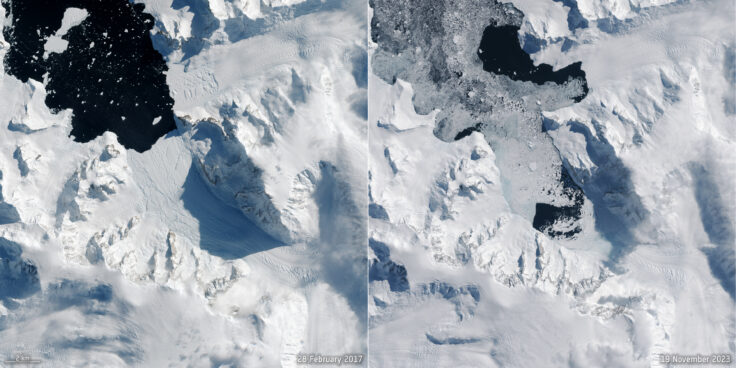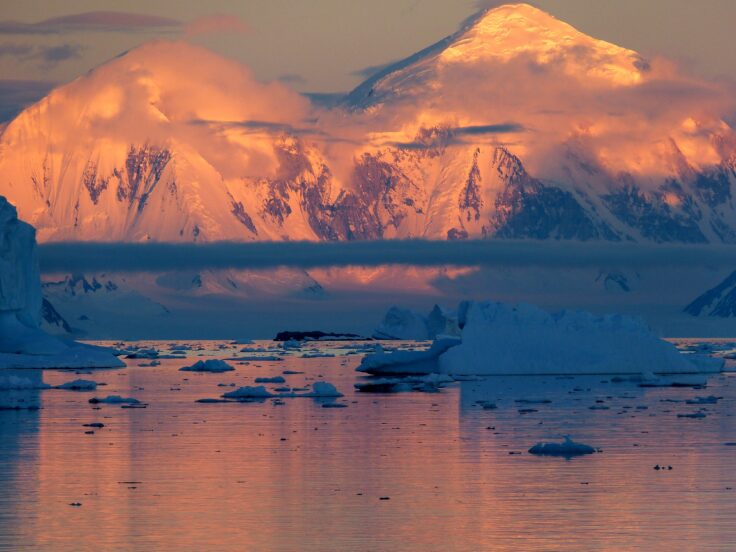Scientists track rapid retreat of Antarctic glacier
Scientists are warning that apparently stable glaciers in Antarctica can change rapidly and lose large quantities of ice as a result of warmer oceans.
Using satellite data, a team discovered that the ice shelf extending into the ocean from Cadman Glacier on the west of the Antarctic Peninsula has collapsed, with the glacier accelerating and retreating rapidly, and identified unusually warm ocean water as the cause.
The research, published today (28 November) in the journal Nature Communications, describes how a team of international scientists from British Antarctic Survey (BAS), the University of Leeds, Lancaster University, ENVEO and the University of Delaware, used data from nine different satellite missions, including ESA’s CryoSat and Europe’s Copernicus Sentinel-1, along with in-situ measurements to map how the floating ice shelf and glacier changed.
They found that between November 2018 and May 2021, the glacier retreated eight kilometres, after being stable for around 50 years.

They think that unusually high ocean water temperatures around the west Antarctic Peninsula in 2018–2019 triggered the Cadman Glacier system to change dramatically.
Benjamin Wallis, from the University of Leeds who led the research, explains:
“By tracking Cadman Glacier with satellites we saw that it started speeding up massively in 2018, and when we investigated ocean reanalysis data, we found that the waters nearby were up to 2°C warmer than average at that time. We think the warmer waters gradually started to eat away at the Cadman Ice Shelf from the early 2000s, but possibly from as early as the 1970s.
“The warmer water was not only on the surface of the ocean, but also deep in the water column. This warmer water may have reached to where the shelf was grounded on the sea floor. The result being that the ice shelf was melting from the bottom up, which we were able to observe using satellite data.”
Extending from glaciers on land, ice shelves float on the ocean surface and sometimes reach the ocean floor where they can be anchored, or grounded. Importantly, ice shelves act as a buttress, slowing the flow of the glacier towards the sea.
The Cadman Ice Shelf became so thin that it was no longer able to hold back the glacier. In 2019, the shelf broke free from the grounding zone, in effect slipping anchor and enabling the Cadman Glacier to speed up and drain more ice into the sea.
According to this new research, the Cadman Glacier is now in a state of ‘substantial dynamic imbalance’.

The ice on the glacier has continued to thin, losing 20 metres a year in height, which is equivalent to a loss in height of a five-storey building each year. And around 2.16 billion tonnes of ice are draining from the Cadman Glacier into the ocean each year.
The researchers say what has happened to the Cadman Glacier can be seen as an example of a ‘glaciological tipping point’, where a system in a steady state can take one or two paths based on a change in an environmental parameter. A tipping point was reached in 2018 caused by the arrival of unusually warm ocean water, which caused the ice shelf to unground. Reaching this tipping point caused Cadman Glacier to increase its ice discharge by 28% in 13 months.
Co-author Professor Michael Meredith, a BAS oceanographer who specialises in how Antarctica is influencing the oceans, is attending COP28 in Dubai. He says:
“We have known for some time that the ocean around Antarctica is heating up rapidly, and that this poses a significant threat to glaciers and the ice sheet, with consequences for sea-level rise globally. What this new research shows is that apparently stable glaciers can switch very rapidly, becoming unstable almost without warning, and then thinning and retreating very strongly.
“This emphasises the need for a comprehensive ocean observing network around Antarctica, especially in regions close to glaciers that are especially hard to make measurements.”
ESA’s Mark Drinkwater added,
“Again we see that the Antarctic is more susceptible to change than we thought a few years ago. It is imperative that we continue to monitor this fragile continent and the seas around it. We can only get the full picture of change with the measurements that we get from satellites over decades.
“Thankfully, we have missions such as CryoSat and Copernicus Sentinel-1 in orbit, but, importantly, we are developing new satellite missions such as the Copernicus Sentinel Expansion Mission Cristal and Sentinel-1 Next Generation to continue and enhance these types of measurements in the future.”
Ocean warming drives rapid dynamic activation of marine-terminating glacier on the west Antarctic Peninsula, by Wallis, B.J., Hogg, A.E., Meredith, M.P. et al. is published in Nature Communications 14, 7535 (2023).